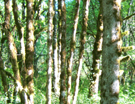Seeding the future: Tree farmers are turning to majestic redwoods for long-term investments
By Diane Dietz, The Register-Guard, November 15, 2009 [here]
Imagine the Coast Range around Noti and Veneta becoming the land of the giant coastal redwood — the tallest tree on earth, the one you can drive your car through.
Some tree farmers are doing more than imagining. They’re planting at least 20,000 coastal redwood trees a year in Lane and Douglas counties, according to the Cottage Grove seedling grower Plum Creek.
They’re driven less by fancy, or the awe the big trees inspire in many people, than by what they see as the best return on their investment in 30 or 40 years, when the trees are harvested.
Coastal redwoods put on volume three or four times as fast as Douglas fir, said Doug Wolf, a Douglas County forester. They can produce a “phenomenal” 5,000 board feet per acre per year. Plant them in blackberries, they shoot up through the fir-killing shade. Cut one down, and the stump will sprout a half dozen new trees. Let a deer or elk eat the tender tops, it can still grow up to 350 feet tall.
“They are quite the rejuvenator,” forester Dick Rohl said. “If you got any mass there, they’ll just take off like the dickens.”
“Like a weed practically,” Wolf added.
But the most compelling fact for those tree farmers planting coastal redwoods this year: Redwood logs are selling for $800 to $1,300 per thousand board feet compared with less than $250 for Douglas fir, according to Random Lengths, a wood products trade publication based in Eugene.
The Lane and Douglas tree farmers planting coastal redwood are betting that time will only widen that price gap.
Chapter 8: Tree Farm Stewardship
From A Guide to Innovative Tree Farming in the Pacific Northwest by Mike Dubrasich. 2005. Whirlwind Press. For a hard copy of the book ($10 - includes shipping) please contact W.I.S.E. [here].
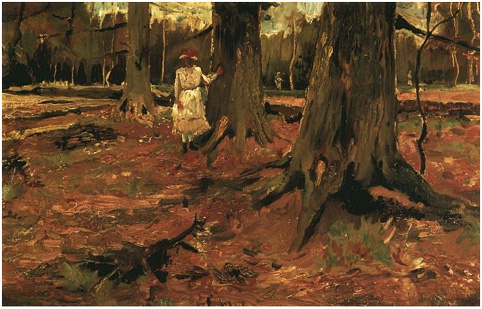
Tree farming is an enjoyable, worthwhile, and honorable occupation. Those of us lucky enough, or determined enough, to be tree farmers are privileged to be able to do it. With that privilege comes the responsibility to be good stewards of the land.
Tree farm stewardship is using property to produce commodities while preserving the intrinsic productivity of the land. Tree farm practices should never abuse, erode, pollute, or otherwise render land, yours or your neighbor’s, unfit for agriculture. Good stewardship means protecting water and air quality, too. Fortunately, good stewardship and innovative tree farming go hand-in-hand.
Ownership of tree farms by individuals and families promotes good stewardship. Stewardship is a relationship between the landowner and the land. People develop deep psychological identifications with property. For landowners especially, our properties become part of our identities. Owners care for their lands as they care for themselves and their families. The landowner who harms his property harms himself, and generally loses his land. Public land, property that no individual can claim as a unique identity, receives notoriously bad stewardship.
Public policies aimed at achieving good land stewardship should promote private property ownership. It’s in the public’s interest to have a free market in land, without monopolies or government-owned agri-businesses. It’s in the public’s interest to prevent pollution and land degradation, and private individual ownership provides that stewardship function better than any other form of land ownership.
The exceptions to this rule might be parks, forests, and nature preserves. We need wild places, and privately-owned property is never truly wild. This is not to say that private property owners should never grow forests, but the luxury is beyond the means of most of us. Only public lands hold the possibility of growing real forests. Real forests are big; they are vast stretches of natural ecosystem. I hope that someday public agencies will learn how to be good stewards of parks, forests, and nature preserves.
Innovative and successful tree farmers form deep bonds with their properties. Tree farmers are there when the rising sun shafts through the trees, when the rains fall, when the breezes blow, when the flowers bloom, when the birds sing, and when the setting sun paints the sky. Tree farmers kneel to plant seedlings in acts of faith, and watch year after year as the trees fulfill their promise and grow toward the sky. Tree farmers are grown on tree farms, too. Of such stuff is great stewardship made.
Chapter 7: Putting It All Together
From A Guide to Innovative Tree Farming in the Pacific Northwest by Mike Dubrasich. 2005. Whirlwind Press. For a hard copy of the book ($10 - includes shipping) please contact W.I.S.E. [here].
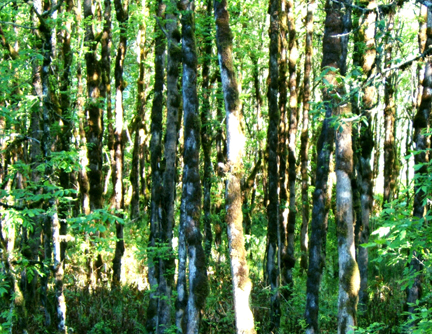
Innovative tree farmers grow multiple species of trees, shrubs, and herbaceous plants for commercial purposes. Growing a single species for a single harvest many decades away is too unprofitable for serious tree farmers. Moreover, the transition from mono-cropping slow-growing species to multi-cropping fast-growing species is almost too easy to avoid. Observant tree farmers reading this book will realize that other commercial species besides Douglas-fir are already growing on their tree farms.
Tree farmers know that good planning is important. Planning increases productivity, efficiency, and profitability. Tree farmers who plan for their transition to growing the best species will be more successful than those who fall into it accidentally.
Proper tree farm plans have four parts: inventory, goals, treatments, and monitoring. The first step in planning is to inventory and evaluate the soil, topography, climate, existing plants, and plants that could potentially grow on your property. The next step is to decide what tree farm products you wish to produce and market; tree farming is a business, and marketing is central to any business plan. Next, prepare a schedule and budget for the treatments and practices you will apply to accomplish your production and marketing goals. Finally, devise a system for measuring and recording what you do and how the trees are growing. In addition to these four fundamental steps, you may wish to consider the following 12 recommendations for inclusion in your new tree farm plan.
Chapter 6: The Best Herbaceous Plants
From A Guide to Innovative Tree Farming in the Pacific Northwest by Mike Dubrasich. 2005. Whirlwind Press. For a hard copy of the book ($10 - includes shipping) please contact W.I.S.E. [here].
Best of the Best: Sword Fern (Polystichum munitum)
Runner-Up: Stinging Nettle (Urtica dioica ssp. gracilis)
Herbaceous plants are low-growing and non-woody, about as far from being trees as a plant can get. Most commercial herbaceous plants are more efficiently grown by row-cropping, or as nursery plants, not as tree farm crops. Nevertheless, innovative tree farmers also grow certain commercially valuable herbaceous plants that thrive in shade, and are easy to grow, harvest, and market.
Sword Fern
Sword ferns occur naturally in forests from Alaska to California and east to Montana, although they are more abundant in forests west of the Pacific Crest. Sword ferns survive in full sun (after clearcutting, for instance) but attain their best growth in shade.
Sword ferns have two markets: as live plants or as cut fronds for floral greenery. Nurseries, not tree farms, are the best places to grow live plants for commercial sale. Tree farms are good places to grow sword ferns for their fronds. Fresh-cut fronds are sold to domestic florists and international floral brokers. The market for Pacific Northwest sword fern fronds is truly world-wide.
One caveat tree farmers should be aware of is that the U.S. Forest Service currently encourages sword fern picking on public forests by commercial gatherers. This sad policy is harmful to the forests and harmful to the pickers. The tragic consequences are too numerous to detail here. One consequence, however, is that the ill-conceived Federal harvest depresses sword fern frond prices.
Chapter 5: The Best Shrubs
From A Guide to Innovative Tree Farming in the Pacific Northwest by Mike Dubrasich. 2005. Whirlwind Press. For a hard copy of the book ($10 - includes shipping) please contact W.I.S.E. [here].
Best of the Best: Scouler Willow (Salix scouleriana)
Runners-Up: California Hazelnut (Corylus cornuta var. californica), Oceanspray (Holodiscus discolor)
Honorable Mention: Saskatoon Serviceberry (Amelanchier alnifolia), Lewis Mockorange (Philadelphus lewisii)
Tree farmers plant trees, but shrubs often occur on tree farms naturally. The tree farmer’s choices are to ignore the shrubs, poison them, or make profits from them. Innovative tree farmers choose the third option.
The best tree farm shrubs are easy to grow, easy to market, and provide opportunities to add value. Moreover, the best shrubs provide annual income, and hence greater earning power than a periodic crop. One-year-old shoots (rods) are the products tree farmers harvest from shrubs; coppicing is the method employed. Rods are used in basketry, furniture-making, and a variety of arts and crafts.
Scouler Willow
The best shrub for Pacific Northwest tree farmers to grow is Scouler willow. Taxonomists have identified over 50 species, subspecies, and varieties of willow in our region. Scouler willow is the most common, but many other native willows are excellent rod producers. Scouler willows can grow into small trees, but coppicing keeps them short and manageable.
Chapter 4: The Best Hardwoods
From A Guide to Innovative Tree Farming in the Pacific Northwest by Mike Dubrasich. 2005. Whirlwind Press. For a hard copy of the book ($10 - includes shipping) please contact W.I.S.E. [here].
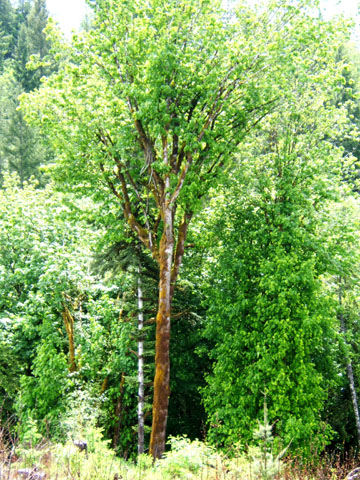
Best of the Best: Bigleaf Maple (Acer macrophyllum)
Runners-Up: Oregon Ash (Fraxinus latifolia), Bitter Cherry (Prunus emarginata)
Honorable Mention: Red Alder (Alnus rubra)
Innovative tree farmers do not limit themselves to growing conifers only; hardwood tree species are too profitable not to grow. In fact, hardwoods can be much more profitable than conifers.
Hardwoods are more properly termed broad-leaved, flowering trees. Most hardwood trees native to the Pacific Northwest are deciduous; in contrast, most of our conifers are evergreens. The wood from hardwood trees is not necessarily hard, but hardwood wood does have a slightly different cellular structure than conifer wood.
Bigleaf maple
Of the hundreds of native hardwood tree species, bigleaf maple is the best of the best to grow on Pacific Northwest tree farms. It’s very fast-growing, easy to grow, produces multiple high-value products starting at a young age, and provides opportunities to add value.
Chapter 3: The Best Conifers
From A Guide to Innovative Tree Farming in the Pacific Northwest by Mike Dubrasich. 2005. Whirlwind Press. For a hard copy of the book ($10 - includes shipping) please contact W.I.S.E. [here].
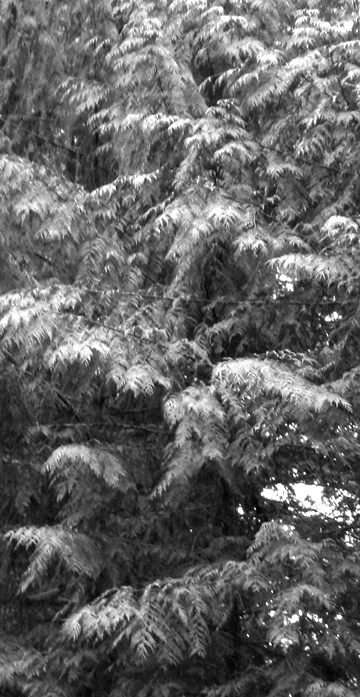
Best of the Best: Western Red Cedar (Thuja plicata)
Runners-Up: Alaska Yellow Cedar (Chamaecyparis nootkatensis), Redwood (Sequoia sempervirens)
Honorable Mention: Noble fir (Abies procera)
There are thousands of native plant species in the Pacific Northwest. Hundreds have some commercial potential as tree farm crops. From these I have selected 15 species that I consider to be the best native plants for innovative tree farming. All 15 can economically out-perform Douglas-fir many times over. Innovative tree farmers are growing many more native species than these, but the 15 selected are the best, in my opinion.
I have divided the best species into four groups: conifers, hardwoods, shrubs, and herbaceous plants. Yes, shrubs and herbaceous plants; innovative tree farmers grow multiple species and harvest multiple products from every acre. From each group I have chosen the Best of the Best, the Runners-Up, and the Honorable Mentions. In this chapter I discuss the best conifers. In the next three chapters I discuss the best hardwoods, shrubs, and herbaceous plants.
Conifers are cone-bearing trees with naked seeds (pine nuts do not have shells). Conifers include pines, firs, cedars, cypresses, hemlocks, yews, larches, and Douglas-fir (Pseudotsuga menziesii). Conifers are also called softwoods, although the actual hardness of conifer wood varies greatly between species.
Western Red Cedar
Western red cedar is the best conifer species to grow on individual and family tree farms in the Pacific Northwest. Cedar produces multiple high-value products, starts producing income at a surprisingly young age, is easy to grow, and provides many opportunities to add value.
Craft fibers Decorative wood Food crops Live plants Markets and Marketing Ornamentals Pharmaceuticals and extracts
by admin
7 comments
Chapter 2: The Ideal Tree Farm Species
From A Guide to Innovative Tree Farming in the Pacific Northwest by Mike Dubrasich. 2005. Whirlwind Press. For a hard copy of the book ($10 - includes shipping) please contact W.I.S.E. [here].
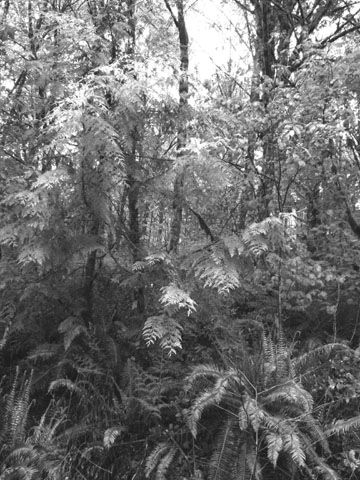
My professional advice to you is don’t plant Douglas-fir on your tree farm. You might find this advice curious because Douglas-fir is the commercial tree species most commonly grown in the Pacific Northwest. Every year billions of board feet are harvested, and hundreds of millions of new Douglas-fir seedlings are planted. What’s the problem? What’s wrong with Douglas-fir?
The problem is that growing Douglas-fir has a huge opportunity cost. Many other species produce more net income per acre per year. Tree farming is a business. Douglas-fir is a poor money maker.
In general the best species to grow would be the one that makes the tree farmer the most money with the least effort in the shortest amount of time. This is profitability: gross sales minus all costs, discounted to the present. To meet the profitability goal, the ideal tree farm species should have the following characteristics:
1. Fast growth, reaches harvest age quickly.
2. Easy to grow, with minimal up-front capital investment, and low maintenance, culturing, and harvesting costs.
3. Produces valuable products, preferably for expanding markets.
4. Provides the tree farmer the opportunity to add value to the products
Let’s examine these ideal characteristics one at a time.
Chapter 1: An Introduction to Innovative Tree Farming
From A Guide to Innovative Tree Farming in the Pacific Northwest by Mike Dubrasich. 2005. Whirlwind Press. For a hard copy of the book ($10 - includes shipping) please contact W.I.S.E. [here].
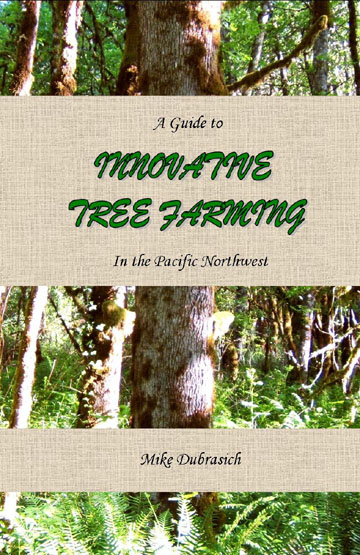
If you own rural property in the Pacific Northwest, then this book is for you. Tree farming is one of the best ways to use your property. It’s relatively easy, non-polluting, low maintenance, interesting, and it can be very profitable, too.
Tree farming is the art and science of growing, harvesting, and marketing large, woody plants. Trees are fascinating, lovely, noble, and enjoyable to grow. Tree farming is also a business, one that uses natural phenomena (plants, soil, rain, and sunshine) to produce commercial goods and materials. Most rural landowners grow trees on their property, and many of them make money harvesting sawlogs, Christmas trees, firewood, boughs, cones, or hundreds of other tree products. That’s tree farming. Many so-called “forests” in the Pacific Northwest are actually tree farms: plantations of trees grown to be commercially harvested. (Orchards and nurseries are also types of tree farms, but they are outside the scope of this book.)
Tree Farms Are Not Forests
Warning: this essay shifts a paradigm. Please remain seated while reading, to avoid injuries from fainting.
Ready? Here it is: tree farms are not forests and forests are not tree farms. The Old Paradigm holds that they are the same thing. The New Paradigm, presented herein, says they are completely and utterly different land uses. Well, maybe not utterly. Tree farms and forests both have trees. Other than that, the differences are starkly obvious and fundamental. Understanding the differences will benefit you, whether you are pro-tree farms, pro-forests, or pro-both, like me.
How are tree farms and forests different? Let us count the ways. First, they are structurally different. By “structure” I mean the three- dimensional, above-ground lattice: the stems, branches and leaves that constitute the architectural framework.
On tree farm plantations the trees are all the same age, down to the week or day of planting. They are evenly spaced. As they grow, all the trees have similar heights, crown shapes, crown lengths, and stem diameters. Structure is homogeneous.
In forests the trees are never the same age. Even in so-called “even- aged” forests, stem recruitment actually lasts for many decades following stand replacement disturbance. In forests the trees are never evenly spaced. As differently aged and spaced trees grow, they diversify into unequal heights, crown shapes, crown lengths, and stem diameters. Structure in forests is heterogeneous horizontally and vertically.
Second, tree farms and forests are different biologically. Tree farm stands have only a few tree species, sometimes only one. Very few other plant species occur, especially under the dense canopies of fully- stocked plantations. Nor do many wildlife species find preferred habitat on tree farms, because of the structural and biological limitations.
A Guide to Innovative Tree Farming In the Pacific Northwest
Revolutionary! Controversial! Agricultural!
Attention! PNW tree farmers and rural landowners!
Escape the Douglas-fir trap and make more money growing profitable new tree crops with new methods for new and expanding markets!
A Guide to Innovative Tree Farming In the Pacific Northwest was written by an independent tree farm consultant originally for his private clients. Innovative Tree Farming reveals tree farming secrets that can turn your woodlot, brush patch, or hay field into a veritable gold mine!
Don’t delay. Read Innovative Tree Farming and then get growing! The first ones in capture market share!
If you own rural property in the Pacific Northwest, you need to read this book!
Increase your income and land equity by farming high-value, fast-growing, native trees, shrubs, and herbaceous plants. Profit-making opportunities and tree farming secrets revealed in print. Get your copy today! Order [here]
